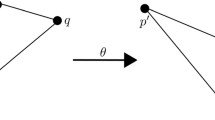Abstract
In this paper, we associate a weight function with a set of points satisfying the conditions of the cylinder conjecture. Then we derive properties of this weight function using the Rédei polynomial of the point set. Using additional assumptions on the number of non-determined directions, together with an exhaustive computer search for weight functions satisfying particular properties, we prove a relaxed version of the cylinder conjecture for \(p \le 13\). This result also slightly refines a result of Sziklai on point sets in \(\mathrm {AG}(3,p)\).
Similar content being viewed by others
References
Alon N.: Combinatorial nullstellensatz. Combin. Probab. Comput. 8(1–2), 7–29 (1999). Recent trends in combinatorics (Mátraháza, 1995).
Ball S.: On the graph of a function in many variables over a finite field. Des. Codes Cryptogr. 47(1–3), 159–164 (2008).
Ball S., Lavrauw M.: On the graph of a function in two variables over a finite field. J. Algebr. Comb. 23(3), 243–253 (2006).
Blokhuis A.: Private communication (2017).
Blokhuis A., Marino G., Mazzocca F.: Generalized hyperfocused arcs in \(PG(2, p)\). J. Comb. Des. 22(12), 506–513 (2014).
Sziklai P.: Directions in \({\rm AG}(3, p)\) and their applications. Note Mat. 26(1), 121–130 (2006).
Acknowledgements
The authors acknowledge Aart Blokhuis and Klaus Metsch for the fruitful discussions on the combinatorial part (Sect. 2).
Author information
Authors and Affiliations
Corresponding author
Additional information
Publisher's Note
Springer Nature remains neutral with regard to jurisdictional claims in published maps and institutional affiliations.
This is one of several papers published in Designs, Codes and Cryptography comprising the “Special Issue on Finite Geometries”.
Jan De Beule acknowledges the Fund prof. Frans Wuytack of Ghent University for a research. Péter Sziklai acknowledges the FWO-HAS mobility project; and NN 114614 and K 120154 research grants.
Appendix: Computer search for the weaker cylinder conjecture
Appendix: Computer search for the weaker cylinder conjecture
This Appendix gives the main ideas of the computer search for polynomials \(w(X,Y) \in \mathbb {F}_p[X,Y]\) satisfying Properties 1. Recall that the third property is equivalent to the total degree of w being at most \(p-3\).
Define a zero line to be a line in \(\mathbb {F}_p^2\) such that \(w(x,y) = 0\) for all points (x, y) on that line. The zero lines correspond exactly to the linear factors of w(X, Y). So, there can be at most \(p-3\) zero lines and there is certainly a parallel class of lines without a zero line.
Now we choose coordinates such that there is no zero line with equation of the form \(Y = c\) and such that w(X, Y) has a factor \(X(X-Y)\) (instead of XY earlier). For a fixed y, we know that \(\sum _{x \in \mathbb {F}_p} \mathrm {lift}(w(x,y))\) is \(0 \bmod p\) but non-zero. So it must be at least p. Since \(\sum _{y \in \mathbb {F}_p}\sum _{x \in \mathbb {F}_p} \mathrm {lift}(w(x,y)) = p^2\), we must have \(\sum _{x \in \mathbb {F}_p} \mathrm {lift}(w(x,y)) = p\) for every fixed y.
The idea of the algorithm is to cut w into 1-dimensional strips and then glue these together. As a first (and easy) step, for every fixed value of \(y \in \mathbb {F}_p\setminus \{0\}\) we determine all possibilities for the polynomial \(w_y(X) := w(X,y) \in \mathbb {F}_p[X]\). Here, the conditions are:
-
1.
\(w_y(0) = 0\) and \(w_y(y) = 0\);
-
2.
\(\sum _{x \in \mathbb {F}_p} \mathrm {lift}(w_y(x)) = p\);
-
3.
\(w_y(X)\) is a polynomial of degree \(\le p-3\).
Once this is done for \(y = 1\), one can easily deduce the possibilities for the other \(y \ne 0\). For a fixed y, the number of polynomials is rather small: there are only 43 such polynomials for \(p = 7\); there are 6863 polynomials for \(p = 11\) and 87, 995 for \(p = 13\).
Now we must “glue” together these 1-dimensional strips of w to a function on \(\mathbb {F}_p^2\). When we do this, we get extra conditions coming from the fact that the total degree of w must be \(\le p-3\). For example, the coefficient of \(X^{p-3}\) of the univariate \(w_y(X)\) must equal the coefficient of \(X^{p-3}\) of the bivariate w(X, Y). Therefore, we have a gluing condition saying that the coefficient of \(X^{p-3}\) in \(w_1(X)\) and \(w_2(X)\) must be the same. In general, the number of conditions for adding a strip is equal to the number of strips that we already have. So, if the number of 1-dimensional strips is N, one expects about \(N^k/p^{\left( {\begin{array}{c}k\\ 2\end{array}}\right) }\) possibilities for k glued strips.
This gluing is done using a backtracking algorithm. In the implementation we used hash tables to speed up checking the allowed strips that could be added to a given list of strips. We stop when we have glued \(p-2\) strips. At that point, the whole function w(X, Y) is determined.
This way, we find some almost solutions which satisfy Properties 1 except that the sum of the lifts may be larger than \(p^2\). For \(p = 7\) and \(p = 11\), the smallest possible value for \(\sum _{x,y \in \mathbb {F}_p}\mathrm {lift}(w(x,y))\) is \(p^2 + p\) and for \(p = 13\) it is \(p^2 + 2p\).
Rights and permissions
About this article
Cite this article
De Beule, J., Demeyer, J., Mattheus, S. et al. On the cylinder conjecture. Des. Codes Cryptogr. 87, 879–893 (2019). https://doi.org/10.1007/s10623-018-0571-5
Received:
Revised:
Accepted:
Published:
Issue Date:
DOI: https://doi.org/10.1007/s10623-018-0571-5




